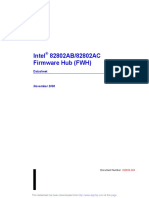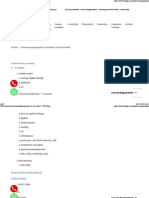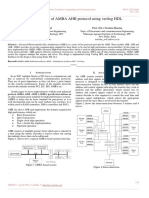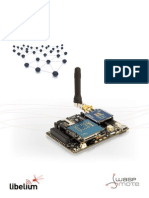Pcie Intel Specification
Pcie Intel Specification
Uploaded by
dipin555Copyright:
Available Formats
Pcie Intel Specification
Pcie Intel Specification
Uploaded by
dipin555Original Title
Copyright
Available Formats
Share this document
Did you find this document useful?
Is this content inappropriate?
Copyright:
Available Formats
Pcie Intel Specification
Pcie Intel Specification
Uploaded by
dipin555Copyright:
Available Formats
Taking Advantage of the PCI Express Specification
ABSTRACT: By understanding the topology-related aspects of the PCI Express
specification, you can plan effectively and implement your design with greater
confidence. Certain connectivity rules and conventions apply to PCI Express
signals just as with any other interface. However, some inherent features that are
built into the specification make your life as the system designer somewhat
easier. This article explores these features, as well as system-level floor-planning
to position your system for success.
Connectivity Rules
As you learn to apply the PCI Express specification’s connectivity rules to your
designs, you can take full advantage of the allowances for PCI Express topologies
and layouts. The following requirements and guidelines apply specifically to
connectivity:
Each connection between PCI Express devices must be point-to-point. In
other words, a connection can only exist between one driver and one
receiver. Daisy-chaining, or connections of multiple transmitters and
receivers on one wire or interconnect, is not allowed. You should make sure
that all components in your designs are routed such that they directly
connect with just one other PCI Express component.
Do not confuse this rule with link bifurcation and link width negotiation, in
which point-to-point lanes are grouped together to form up to x32 links
between two separate devices.
The PCI Express specification dictates that each lane of a link be AC-coupled
between its corresponding transmitter and receiver. The AC coupling
capacitance is required either within the transmitter component/package or
along the interconnect link on the Printed Circuit Board (PCB). In most
scenarios, the AC coupling must be located external to the transmitter or
receiver device components in the form of discrete capacitors on your
system PCB. It is your responsibility to verify the AC coupling capacitor
requirements of each PCI Express Transmit (TX) component in your design.
Each end of a PCI Express link is terminated on-die into a nominal 100 Ω
differential DC termination. This is often done by using 50 Ω terminations
on each signal of the differential pair. Because each component contains
this on-die termination, you do not need to worry about any external on-
board terminations for the PCI Express high-speed differential pairs in your
system.
The PCI Express specification also requires each TX component to utilize on-
Copyright © 2009 Intel Corporation 1
die equalization by means of de-emphasis for all PCI Express signals. The
de-emphasis is required to be a typical value of 3.5 dB (±0.5 dB) down with
respect to the nominal output voltage. You are not required to include any
additional external equalization for the differential pairs in your design.
Each lane on a PCI Express link is assigned a sequential numerical value
and is identified as such in the component’s pinout. Each TX pair on a
transmitting device must connect with the identically numbered Receive
(RX) pair on the receiving device. For example, two devices that constitute
a link with a width of x1 might be identified as device A and device B. To
represent the D+ or D– signals, respectively, a ―p‖ or ―n‖ is usually
appended to the pin name. Each device’s respective TX and RX labels would
then be similar to the following:
A_PETp0, A_PETn0, A_PERp0, A_PERn0
B_PETp0, B_PETn0, B_PERp0, B_PERn0
To properly connect device A to device B, device A’s TX pairs (A_PETp0,
A_PETn0) should connect to device B’s RX pairs (B_PERp0, B_PERn0) and
vice versa. The same connectivity rules apply regardless of link size,
including x16 or x32 links. For possible exceptions to this guideline, see the
following section, ―Bowtie Topology Considerations.‖
Bowtie Topology Considerations
When physically routing or interconnecting PCI Express devices, whether across a
connector or on the same PCB, you might encounter one of the following ―bowtie‖
or signal-crossing scenarios:
D+, D– crisscrossing within a pair. This scenario occurs when the D+ and
D– signals of a differential pair from a transmitter device must crisscross in
order to connect to the respective D+ and D– signals of the receiving
device.
Crossing of lanes. This scenario occurs on a x2 or greater link, when lane 0
of the transmitting device must cross the other lanes in order to connect
with lane 0 on the receiving device.
Crossing of transmit and receive pairs within a lane. This scenario occurs
when the transmit and receive differential signal pairs that constitute an
individual lane must crisscross each other in order to properly connect from
one device to another.
To help you overcome the first two scenarios, the PCI Express Base Specification
includes provisions for two features: polarity inversion and lane reversal. The
specification does not provide a provision to overcome the third scenario.
Copyright © 2009 Intel Corporation 2
Scenario 1: Crisscrossing Within a Pair—Making Use of Polarity Inversion
The PCI Express specification requires support for polarity inversion. This feature
allows for the TX and RX devices to fix any connections automatically within a
lane where the D+ and D– connections are reversed. Figure 1 illustrates polarity
inversion.
Polarity inversion can make your life as a designer a lot easier. First, the inversion
process is completely transparent and automatically happens on-die, within the
component, becoming enabled only when necessary. As the system designer, you
don’t need to do anything to make it work! Second, you no longer have to
scrutinize your CAD layout, doublechecking all the differential pairs; polarity
inversion effectively neutralizes the differential pair, and the D+ and D–
designations may in fact become unnecessary during layout. You can simply tell
your CAD layout engineer to ―connect TX pair A to RX pair B and don’t worry
about the + and – signs.‖ For debug purposes, it still makes sense to keep track
of which signals are D+ and which are D–, but polarity inversion makes them
irrelevant for layout purposes.
Figure 1 Polarity Inversion on an RX to TX Interconnect
Making use of polarity inversion allows you to reduce the number of via
transitions for your differential signals, have a more uniform differential route on
the PCB, and subsequently reduce the amount of PCB real estate used for
differential pair routing.
Scenario 2: Crossing of Lanes—Making Use of Lane Reversal
The PCI Express Base Specification does not require support for this optional
feature. Where supported, lane reversal allows you to reassign the TX and RX
lane 0 pairs on a given device to connect respectively to the highest ordered lane
Copyright © 2009 Intel Corporation 3
RX and TX pairs on a second device, and so on for the entire link.
Only one component forming part of a link needs to support lane reversal in order
to make it operational. Consider an example design with a x8 component, located
on the system PCB, that supports lane reversal and is routed to a connector
interface. In such a scenario, if the x8 component pinout is ―reversed‖—forcing
you to crisscross lanes in order to properly route and connect lane 0 through lane
7 with the connector—you could simply rearrange the link so that lane 0 of the x8
PCB component is now connected with lane 7 of the connector. The remaining
lanes would be similarly connected such that lane 1 of the PCB component would
now connect with lane 6 of the connector, and so on. Figure 2 illustrates this
scenario.
Figure 2 Example of Lane Reversal on a x8 Link
Unless you are certain that lane reversal is supported and guaranteed by at least
one of the devices in question, do not rely upon this feature. Instead, follow the
basic connectivity rules, which dictate that the lane 0 differential pairs on the first
device must connect to the lane 0 pairs on the second device or connector.
Scenario 3: Crossing of Transmit and Receive Pairs Within a Lane—Making Use of
Vias and Layer Transitions
While polarity inversion and lane reversal help to overcome the first two bowtie
scenarios, the PCI Express Base Specification does not include any provisions to
alleviate the third bowtie scenario. Simply put, an RX input on a device always
remains an RX input and cannot switch roles to become a TX output. If you find
Copyright © 2009 Intel Corporation 4
that your particular design forces you to crisscross RX and TX pairs within a lane,
you must untangle them during layout by means of bowtie routing—using vias to
transition layers in order to alleviate RX and TX pair crisscrossing. Figure 3
depicts this scenario.
Figure 3 Bowtie Routing to Alleviate Crisscrossing RX/TX Pairs
System-level Floor-planning
Proper floor-planning for PCI Express interfaces allows you to position your
system for success before any actual CAD time is spent routing—or re-routing—
the interface. A simple approach to floor-planning might involve these basic
steps:
1. Create a block diagram connectivity plan for devices and/or connectors and
placement studies. In addition to the actual PCI Express components, your
initial diagram should include the necessary peripheral components
interacting with your PCI Express components: clock sources, power supply
connectors, and the like. As you apply this diagram to initial placement
studies with your CAD tools, you can size up the general location on the
system board of each component and assess the routing distances and
areas that apply to each component or connector. The location and
placement of your components is also influenced by the type of system
board form factor you follow, such as ATX, micro-ATX, BTX, etc.
2. Verify connectivity rules, as explained in this article. Making sure that you
comply with all of the specification requirements can save you from design
changes down the road. Note general locations of AC capacitors and verify
whether the pinouts of the PCI Express devices and components require
any bowtie routing to achieve proper connectivity. Also follow the EMI and
Power Delivery guidelines, and determine the ability to maintain good
Copyright © 2009 Intel Corporation 5
reference planes for your signals and place high power consuming devices
close to their power sources.
3. Assignment of routing restrictions. You should revisit this step several times
throughout your design. For four-layer desktop designs, begin by using the
routing length guidelines in this article. After applying the initial trace
length recommendations, refine your initial floor-planning in Step 1 so that
all devices and components conform to the maximum routing length limits
for your design. Then conduct your own simulations. By following this
approach, you can properly customize the layout guidelines for your own
particular situation.
Your floor-planning hinges on the type of design you are undertaking—whether it
be a desktop, server, mobile, communications, or even a customized design lying
somewhere in between—and the associated variations of the PCI Express
specifications that you plan to follow.
Routing Length Recommendations and Restrictions
As mentioned in Step 3 above, successful floor-planning involves an early
consideration of the routing length restrictions and requirements for the PCI
Express differential signals. While each design dictates its own requirements, it is
possible to state some general guidelines, based on a common implementation.
Table 1 presents a summary of PCB-related PCI Express microstrip routing criteria
for a common four-layer board. Designs that are not four-layer microstrip
implementation will of course have slightly different guidelines. The
recommendations in the table are based on system-level simulations and test
board implementations. You can use the length recommendations in the table to
ensure that as you do the floor-planning for a four-layer microstrip design, you
also meet the timing/jitter and loss/attenuation budgets across the entire PCI
Express interconnect path.
Copyright © 2009 Intel Corporation 6
Table 1 Example PCB Routing Guidelines for a Common Microstrip-Routed, 2116 Dielectric-
Based, Four-Layer PCB
While the general physical guidelines and suggestions in Table 1 help to ensure
good high-speed signal design practices, they might not necessarily guarantee
adequate performance of the interconnect for all layout variations and
implementations. In fact, these guidelines should only be applied to designs
where a four-layer, 2116-based dielectric is used for the PCB stack-up.
For more information about PCI Express, please refer to the book PCI Express
Electrical Interconnect Design by Dave Coleman, Scott Gardiner, Mohammad
Kolbehdari, and Stephen Peters.
About the Authors
Copyright © 2009 Intel Corporation 7
Scott Gardiner is a Senior Hardware Engineer at Intel and holds a Master's
degree in Electrical Engineering. Since joining Intel in 1997, Scott has made
significant contributions to various high-speed interconnect and PCB designs.
Involved with PCI Express since its inception, Scott was the lead engineer on one
of Intel's first prototype PCI Express boards and a key contributor to Intel's first
PCI Express desktop motherboard.
Dave Coleman is a Platform Application Engineer with 19 years of electrical
engineering experience. At Intel, he specializes in electrical modeling and
simulation of PCI Express platform designs. Dave is the co-author and editor of
Intel's PCI Express Design Guide, and regularly contributes articles to Printed
Circuit Design magazine.
Stephen Peters leads a group at Intel developing methodologies for validating
next generation chip and board-level interfaces for PCI Express. Over the past 15
years, Stephen has designed high-speed bus interfaces and solved signal integrity
issues. From 2001 through 2003, he served as chair of the I/O Buffer Information
Specification (IBIS) Open Forum and continues to be major contributor to the
IBIS specification.
Mohammad Kolbehdari is a Senior Staff Hardware Engineer at Intel involved
with PCI Express interconnect design and simulation. He developed a 3D full-
wave modeling methodology for high-speed bus and package design used
extensively throughout Intel and is currently creating second-generation PCI
Express design guidelines. Mohammad holds a PhD in Electrical Engineering and
is a regular contributor to IEEE professional journals, COMPEL, and Journal of the
Franklin Institute.
Copyright © 2009 Intel Corporation. All rights reserved.
This article is based on material found in book PCI Express Electrical Interconnect
Design by Dave Coleman, Scott Gardiner, Mohammad Kolbehdari, and Stephen
Peters. Visit the Intel Press web site to learn more about this book:
http://www.intel.com/intelpress/sum_pcieh.htm
No part of this publication may be reproduced, stored in a retrieval system
or transmitted in any form or by any means, electronic, mechanical,
photocopying, recording, scanning or otherwise, except as permitted under
Sections 107 or 108 of the 1976 United States Copyright Act, without either
the prior written permission of the Publisher, or authorization through
payment of the appropriate per-copy fee to the Copyright Clearance Center,
Copyright © 2009 Intel Corporation 8
222 Rosewood Drive, Danvers, MA 01923, (978) 750-8400, fax (978) 750-
4744. Requests to the Publisher for permission should be addressed to the
Publisher, Intel Press, Intel Corporation, 2111 NE 25 Avenue, JF3-330,
Hillsboro, OR 97124-5961. E-mail: intelpress@intel.com .
Copyright © 2009 Intel Corporation 9
You might also like
- Phy Interface Pci Express Sata Usb31 Architectures PIPE - Rev6 - 2 - 1Document187 pagesPhy Interface Pci Express Sata Usb31 Architectures PIPE - Rev6 - 2 - 1sitaradingNo ratings yet
- Bromley Coverage PaperDocument20 pagesBromley Coverage PaperQuý Trương QuangNo ratings yet
- Gloria in Excelsis Vivaldi Completo PDFDocument80 pagesGloria in Excelsis Vivaldi Completo PDFDenis costaNo ratings yet
- Strings Color Identification ChartDocument9 pagesStrings Color Identification ChartCristian TorricoNo ratings yet
- Island Magic Drum Solo: Dave Weckl Compases 90-110Document2 pagesIsland Magic Drum Solo: Dave Weckl Compases 90-110ugo piazza100% (1)
- Pia Internship ReportDocument14 pagesPia Internship ReportHussain SafdarNo ratings yet
- Sony PMW-300 Serie Manual PDFDocument151 pagesSony PMW-300 Serie Manual PDFEwerton Gustavo Soares GomesNo ratings yet
- Signal Intagrity Simulation of PCIE PDFDocument5 pagesSignal Intagrity Simulation of PCIE PDFvijithacvijayanNo ratings yet
- By Vinayashree: Serial Communication ConceptsDocument18 pagesBy Vinayashree: Serial Communication ConceptsvinayashreeNo ratings yet
- Development of CPLD Based Memory Controller For MPC 603E PPC Based Single Board ComputerDocument38 pagesDevelopment of CPLD Based Memory Controller For MPC 603E PPC Based Single Board ComputerkumarbsnspNo ratings yet
- ECRC CalculationDocument8 pagesECRC CalculationAshwitha ReddyNo ratings yet
- SPI Programming GuideDocument106 pagesSPI Programming GuideidmeriNo ratings yet
- Physical Design - PLACEMENTDocument13 pagesPhysical Design - PLACEMENTSuneel KumarNo ratings yet
- Intel® Management Engine (ME) Firmware Update ProcedureDocument3 pagesIntel® Management Engine (ME) Firmware Update ProcedureCeberiusNo ratings yet
- Intel 82802 Firmware HubDocument53 pagesIntel 82802 Firmware HubDiego A. RiveraNo ratings yet
- A Dual-Core RISC-V Vector Processor With On-Chip Fine-Grain Power Management in 28-nm FD-SOIDocument5 pagesA Dual-Core RISC-V Vector Processor With On-Chip Fine-Grain Power Management in 28-nm FD-SOIRama DeviNo ratings yet
- Microprocessor Lab IV SemDocument80 pagesMicroprocessor Lab IV Semnagaraj0% (2)
- Intel Desktop Board DQ67SW Technical Product SpecificationDocument96 pagesIntel Desktop Board DQ67SW Technical Product SpecificationjcmazzuNo ratings yet
- Behavioral Model of A DDR Memory Controller in A DFi - Frequency Ratio SystemDocument10 pagesBehavioral Model of A DDR Memory Controller in A DFi - Frequency Ratio Systemsantosh soodNo ratings yet
- 02 - 05 PCIe 6.0 PHY LogicalDocument25 pages02 - 05 PCIe 6.0 PHY LogicaljimmyNo ratings yet
- HPPatchDocument83 pagesHPPatchvivkepatNo ratings yet
- UVM Usage For Dynamic Reconfiguration of Complex Designs DVCon India 2014 PaperDocument12 pagesUVM Usage For Dynamic Reconfiguration of Complex Designs DVCon India 2014 PaperKunal PanchalNo ratings yet
- USB Interview Questions PDFDocument8 pagesUSB Interview Questions PDFSivaramireddy GudiseNo ratings yet
- UVM Harness Whitepaper: The Missing Link in Interface ConnectivityDocument10 pagesUVM Harness Whitepaper: The Missing Link in Interface Connectivitysharath h sNo ratings yet
- The Missing Link: The Testbench To Dut Connection: David Rich - Mentor A Siemens BusinessDocument10 pagesThe Missing Link: The Testbench To Dut Connection: David Rich - Mentor A Siemens BusinessMarko NedicNo ratings yet
- Real Time Issues and Process of FixingDocument7 pagesReal Time Issues and Process of FixingRA NDYNo ratings yet
- SATA Transport LayerDocument24 pagesSATA Transport LayerkubendrNo ratings yet
- Asurevip - Tvs Pcie Vip EpDocument2 pagesAsurevip - Tvs Pcie Vip EpprabhakiniNo ratings yet
- Manual BIOS Setup (Intel® 600 Series)Document28 pagesManual BIOS Setup (Intel® 600 Series)Joao Carlos VilhenaNo ratings yet
- USB/IP: A Transparent Device Sharing Technology Over IP NetworkDocument12 pagesUSB/IP: A Transparent Device Sharing Technology Over IP Networkik1xpvNo ratings yet
- Missing Link: Testbench To DUT Connection by David RichDocument9 pagesMissing Link: Testbench To DUT Connection by David RichapninexNo ratings yet
- AHB Lite SpecificationDocument72 pagesAHB Lite SpecificationSuyog Avinash ChutkeNo ratings yet
- Intel Sandy Ntel Sandy Bridge ArchitectureDocument54 pagesIntel Sandy Ntel Sandy Bridge ArchitectureJaisson K SimonNo ratings yet
- PCI SIG Arch OverviewDocument37 pagesPCI SIG Arch OverviewrockymaxdeemannNo ratings yet
- AXI Protocol Short PDFDocument63 pagesAXI Protocol Short PDFpreethamgowda147No ratings yet
- Phy Ip For Pcie 3.0Document2 pagesPhy Ip For Pcie 3.0uparashar1No ratings yet
- Can Protocol Uvm PDFDocument5 pagesCan Protocol Uvm PDFMayank JaiswalNo ratings yet
- Implementing Communication Bridge Between I2C and APBDocument4 pagesImplementing Communication Bridge Between I2C and APBDon RajuNo ratings yet
- AXi Series ManualDocument35 pagesAXi Series ManualRuben NinaNo ratings yet
- LSSTMPDFDocument66 pagesLSSTMPDFthevipulsinhaNo ratings yet
- Cyclone V Avalon-Mm Interface For Pcie Solutions: User GuideDocument173 pagesCyclone V Avalon-Mm Interface For Pcie Solutions: User GuidenonopbmoNo ratings yet
- Cache Coherence: Part I: CMU 15-418: Parallel Computer Architecture and Programming (Spring 2012)Document31 pagesCache Coherence: Part I: CMU 15-418: Parallel Computer Architecture and Programming (Spring 2012)botcreaterNo ratings yet
- Verifying Layered Protocols: - Leveraging Advanced UVM CapabilitiesDocument14 pagesVerifying Layered Protocols: - Leveraging Advanced UVM CapabilitiesAli HmedatNo ratings yet
- Axi Verification Ip V1.0: Logicore Ip Product GuideDocument91 pagesAxi Verification Ip V1.0: Logicore Ip Product GuideQuastnNo ratings yet
- Adv Verif Topics Ch5-Part1Document7 pagesAdv Verif Topics Ch5-Part1SamNo ratings yet
- AXI OCP Protocol Signal Description AXIDocument2 pagesAXI OCP Protocol Signal Description AXISivasubramanian Manickam100% (1)
- VLSI Guru Interview Preparation Questions & Excel Sheet - VLSI GuruDocument9 pagesVLSI Guru Interview Preparation Questions & Excel Sheet - VLSI Gurudvlsi dvlsiNo ratings yet
- EE292A Lecture 1.introDocument61 pagesEE292A Lecture 1.introwuxiangjin08No ratings yet
- High-Speed 8B/10B Encoder Design Using A Simplified Coding TableDocument5 pagesHigh-Speed 8B/10B Encoder Design Using A Simplified Coding Tableasic_master100% (1)
- User Manual Cadence DigitalDocument5 pagesUser Manual Cadence DigitalJennifer StricklandNo ratings yet
- Implementation of AMBA AHB Protocol Using Verilog HDLDocument4 pagesImplementation of AMBA AHB Protocol Using Verilog HDLEditor IJRITCCNo ratings yet
- AXI4-Stream Upsizing Downsizing Data Width Converters For Hardware-In-The-Loop SimulationsDocument3 pagesAXI4-Stream Upsizing Downsizing Data Width Converters For Hardware-In-The-Loop SimulationsbrufoNo ratings yet
- Intelligent High Performance Memory Access Technique in Aspect of DDR3Document6 pagesIntelligent High Performance Memory Access Technique in Aspect of DDR3Jahid HasanNo ratings yet
- System Ver I Log Functional CoverageDocument12 pagesSystem Ver I Log Functional CoverageLakshmisree SajitNo ratings yet
- CBasedStimulus - Verification AcademyDocument10 pagesCBasedStimulus - Verification Academykavindra palNo ratings yet
- Noc Book 4Document271 pagesNoc Book 4gowthamarvjNo ratings yet
- Verilog Tutorial For BeginnersDocument4 pagesVerilog Tutorial For BeginnersNovelyn RabinoNo ratings yet
- System Verilog LectureDocument82 pagesSystem Verilog LectureKhanhLeNo ratings yet
- Pci eDocument19 pagesPci eapi-3760834No ratings yet
- Design & Verification of AMBA APB ProtocolDocument4 pagesDesign & Verification of AMBA APB ProtocolKrishnajithKjNo ratings yet
- Application-Specific Integrated Circuit ASIC A Complete GuideFrom EverandApplication-Specific Integrated Circuit ASIC A Complete GuideNo ratings yet
- Power Systems-On-Chip: Practical Aspects of DesignFrom EverandPower Systems-On-Chip: Practical Aspects of DesignBruno AllardNo ratings yet
- Ece Final Year Project For Blind PDFDocument59 pagesEce Final Year Project For Blind PDFKumaraRajaNo ratings yet
- 101-Electronics Projects-1974 PDFDocument116 pages101-Electronics Projects-1974 PDFMarcelo Passos100% (2)
- Agnus Dei - Jude B. RoldanDocument3 pagesAgnus Dei - Jude B. RoldanReynald Ian CruzNo ratings yet
- Lyrics & Chords of - Kora Kagaz Tha Yeh Mann MeraDocument3 pagesLyrics & Chords of - Kora Kagaz Tha Yeh Mann MeraSandip ChhidalNo ratings yet
- Module I-6 Temperature InstrumentsDocument48 pagesModule I-6 Temperature Instrumentsnabil160874No ratings yet
- Погода в Днепре (Днепропетровске) - РП5Document1 pageПогода в Днепре (Днепропетровске) - РП5Varya GamiyNo ratings yet
- Coalesce MZKLB - XV Lineup Joyful Solemn Final PDFDocument4 pagesCoalesce MZKLB - XV Lineup Joyful Solemn Final PDFjayvee coronelNo ratings yet
- ECEPE3 - Lesson 1 AcousticsDocument42 pagesECEPE3 - Lesson 1 AcousticsGenesis AlquizarNo ratings yet
- Crystal Castles - WikipediaDocument1 pageCrystal Castles - Wikipediabfff6q94j7No ratings yet
- Poetry: Versification:: Poetry Unit English 1A 2010Document16 pagesPoetry: Versification:: Poetry Unit English 1A 2010scarletina100% (1)
- Basic Common - Handling ObjectionsDocument3 pagesBasic Common - Handling ObjectionsenhpadddddNo ratings yet
- Doomsday MachineDocument7 pagesDoomsday MachineguilleNo ratings yet
- Assignment 0f PMDocument14 pagesAssignment 0f PMMirza AzeemNo ratings yet
- EEE 107 Lecture 9 - Analog Pulse ModulationDocument30 pagesEEE 107 Lecture 9 - Analog Pulse Modulation許耕立No ratings yet
- Bailey The Cat 2Document23 pagesBailey The Cat 2haticesila204No ratings yet
- K DramasDocument5 pagesK Dramastaha ansariNo ratings yet
- 01 Waspmote-Datasheet EngDocument34 pages01 Waspmote-Datasheet EngJoanna LeeNo ratings yet
- Kathy Rose - Filmmaker-Performance ArtistDocument10 pagesKathy Rose - Filmmaker-Performance ArtistCecilia TraslaviñaNo ratings yet
- PTP 49600 SSDocument2 pagesPTP 49600 SSAdvantec SrlNo ratings yet
- 92.7 Big FM: Presented By-Aarti Chauhan Ambreen AshrafDocument16 pages92.7 Big FM: Presented By-Aarti Chauhan Ambreen AshrafAarti ChauhanNo ratings yet
- Racheltjie de BeerDocument19 pagesRacheltjie de Beerzombelela6No ratings yet
- The PenthouseDocument7 pagesThe PenthouseJuliet AmaltheaNo ratings yet
- LG E2341v BNTDocument34 pagesLG E2341v BNTIvana AltamiranoNo ratings yet
- Wireless Communication and Networks Sheet 1Document4 pagesWireless Communication and Networks Sheet 1Ahmed El SayedNo ratings yet
- 飞跃6Document363 pages飞跃6api-3830118No ratings yet

























































































